Click on images to enlarge

dense infestation (Photo: Sheldon Navie)
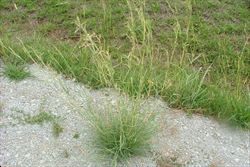
habit (Photo: Sheldon Navie)
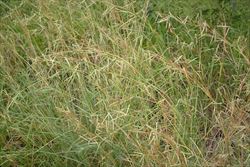
habit (Photo: Sheldon Navie)

tufted leaves at the base of the stems (Photo: Sheldon Navie)

stem and alternately arranged leaves, with leaf sheaths (Photo: Sheldon Navie)
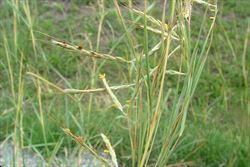
flower spikelets arranged in paired racemes (Photo: Sheldon Navie)
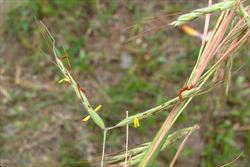
close-up of flower spikelets showing yellow stamens and twisted awns (Photo: Sheldon Navie)

close-up of flower spikelets showing stigmas (Photo: Sheldon Navie)
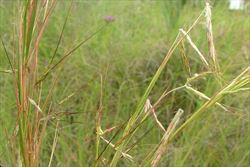
comparison of Tambookie grass (Hyparrhenia filipendula), on the left, and Coolatai grass (Hyparrhenia hirta), on the right (Photo: Sheldon Navie)

comparison of thatch grass (Hyparrhenia rufa subsp. rufa), on the left, and Coolatai grass (Hyparrhenia hirta), on the right (Photo: Sheldon Navie)

'seed-head' branches interspersed with leafy bracts (Photo: Sheldon Navie)

close-up of 'seeds' (Photo: Jose Hernandez at USDA PLANTS Database)
Scientific Name
Hyparrhenia hirta (L.) Stapf
Synonyms
Andropogon hirtus L.
Family
Gramineae (South Australia)Poaceae (Queensland, New South Wales, the ACT, Victoria, Tasmania, Western Australia and the Northern Territory)
Common Names
common thatching grass, Coolatai grass, Tambookie grass, thatching grass
Origin
Native to Africa (i.e. Algeria, Egypt, Libya, Morocco, Tunisia, Eritrea, Ethiopia, Somalia, Sudan, Kenya, Tanzania, Uganda, Cameroon, Niger, Angola, Zambia, Botswana, Lesotho, Namibia, South Africa and Swaziland), the Madeira Islands, the Canary Islands, southern Europe (i.e. Albania, Greece, Italy, Yugoslavia, France, Portugal and Spain), western Asia and the Indian Sub-continent (i.e. north-western India and Pakistan).
Cultivation
This species was introduced as a pasture grass and soil stabiliser for poor-quality soils.
Naturalised Distribution
Widely naturalised in southern and eastern Australia. It is most common and widespread in south-eastern Queensland and north-eastern New South Wales. Also scattered in other parts of these states and locally common in parts of northern Victoria, south-eastern South Australia and south-western Western Australia. Possibly also naturalised in the Northern Territory.
Naturalised overseas in south-western USA (i.e. California) and Hawaii.
Habitat
A weed of roadsides, disturbes sites, waste areas, higher quality pastures, grasslands, rangelands and open woodlands in temperate, sub-tropical and semi-arid regions.
Habit
A long-lived (i.e. perennial) and densely tufted grass usually growing 0.6-1.2 m tall, but occasionally reaching up to 1.5 m in height.
Distinguishing Features
-
a long-lived and densely tufted grass usually growing 0.6-1.2 m tall.
-
its green or bluish-green leaves (2-35 cm long and 1-5 mm wide) are mostly tufted at the base of the plant, but are also alternately arranged along the stems.
-
where the leaf sheath meets the leaf blade there is a small membranous structure 2-4 mm long.
-
its upright flowering stems bear large leafy seed-heads 15-40 cm or more long.
-
its flower spikelets are arranged in elongated clusters (1.5-5 cm long), which are borne in diverging pairs at the tips of slender branches (3-8 cm long).
-
the flower ferile flower spikelets (4-6.5 mm long) are usually topped with twisted awns 10-35 mm long.
Stems and Leaves
The upright flowering stems (i.e. erect culms) are hairless and sometimes covered in a whitish powdery substance when young.
The leaves consist of a sheath, which partially encloses the stem, and a spreading leaf blade. These leaves are mostly tufted at the base of the plant, but are also alternately arranged along the stems. The leaf sheaths are usually hairless (i.e. glabrous) while the leaf blades (2-35 cm long and 1-5 mm wide) are hairless or have a few scattered hairs (i.e. sparsely pubescent). These very elongated (i.e. linear or filiform) leaves are often somewhat bluish-green (i.e. glaucous) in colour, with entire margins and pointed tips (i.e. acute apices). Where the leaf sheath meets the leaf blade there is a small membranous structure (i.e. eciliate ligule) 2-4 mm long.
Flowers and Fruit
The seed-heads are large leafy compound clusters (i.e. synflorescences) 15-40 cm or more long. They consist of several small branches, each subtended by a elongated leafy bract (i.e. lanceolate spatheole) 3-8 cm long that turrns reddish-brown with age. Each of the slender branches (3-8 cm long) bears a pair of diverging elongated flower clusters (i.e. racemes) 1.5-5 cm long at its tip. These racemes each consist of several (4-8) pairs of flower spikelets, the lower spikelet in each pair being fully-formed (i.e. fertile) while the upper spikelet is sterile. The lower spikelet (4-6.5 mm long and about 1 mm wide) is elongated or narrowly-oval (i.e. lanceolate to elliptic) in shape. It consists of a pair of bracts (i.e. glumes) and two tiny flowers (i.e. florets), only the upper one of which produces a seed. These florets have three yellow anthers (0.8-2 mm long) and a two-branched feathery stigma. The fertile spikelets are usually also topped with a finely hairy, twisted, awn (10-35 mm long). The upper spikelet (3-7 mm long) in each pair is borne on a short stalk (i.e pedicel) and is similar in shape but does not have an awn. Flowering occurs throughout the year, but mainly during summer.
The 'seeds' (i.e. grains or caryopses) are contained within the old flower parts, and are usually shed with their awns and the associated sterile spikelets still attached to them.
Reproduction and Dispersal
This species reproduces mainly by seed. These seeds can be spread short distances by wind and can float on water. Roadside slashing, machinery, and animals may also disperse seeds shorter distances, while longer distance dispersal can occur on vehicles, in mud, and in contaminated agricultural produce (i.e. fodder).
Environmental Impact
Coolatai grass (Hyparrhenia hirta) was recently listed as a priority environmental weed in seven Natural Resource Management regions around Australia. It is regarded as an environmental weed in New South Wales, Queensland, Victoria, South Australia and Western Australia.
Legislation
This species is declared under legislation in the following states and territories:
- South Australia: 2* - a Class 2i weed, control of this species is required in some parts of the state (but trade and movement is restricted throughout the entire state).
- Western Australia: Unassessed - this species is declared in other states or territories and is prohibited until assessed via a weed risk assessment (throughout the entire state).
Management
For information on the management of this species see the following resources:
- the Adelaide and Mount Lofty Ranges Natural Resources Management Board weed identification note on this species, which is available online at http://www.amlrnrm.sa.gov.au.
Similar Species
Coolatai grass (Hyparrhenia hirta) can be easily confused with the native Tambookie grass (Hyparrhenia filipendula) and the introduced thatch grass (Hyparrhenia rufa). These species can be distinguished by the following differences:
- Coolatai grass (Hyparrhenia hirta ) is a moderate-sized grass growing 0.6-1.5 m tall. Its paired flower clusters (i.e. racemes) are 1.5-5 cm long and each has 4-8 pairs of flower spikelets. The seeds are topped with relatively short awns 10-35 mm long.
- Tambookie grass (Hyparrhenia filipendula ) is a moderate-sized grass growing 1-1.5 m tall. Its paired flower clusters (i.e. racemes) are 1.5-2.5 cm long and each has only 1-3 pairs of flower spikelets. The seeds are topped with relatively long awns 40-50 mm long.
- thatch grass (Hyparrhenia rufa) is a robust grass growing up to 2.5 m tall. Its paired flower clusters (i.e. racemes) are 1.5-5 cm long and each has 4-10 pairs of flower spikelets. The seeds are topped with relatively short awns 20-30 mm long.

